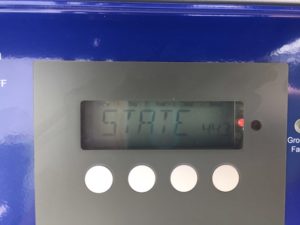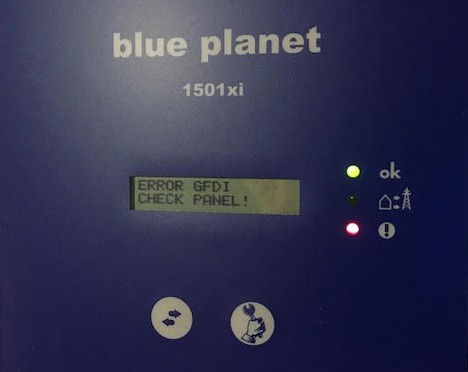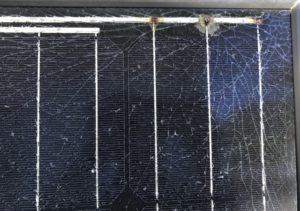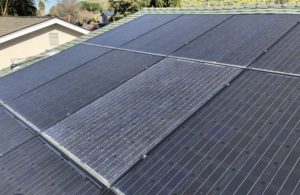Top 5 Solar Repair Problems
Solar Photovoltaic systems are generally maintenance free. However, the effects of weather makes maintenance and repair inevitable. We use state-of-the-art diagnostic tools to troubleshoot your solar system to uncover problems and restore it to its maximum potential. What issues do people typically call us for help? Here are the Top 5 solar repair problems that our customers encounter:
Solar Repair Problem #1: My inverter has a red light on!

The display panel for a Fronius IG inverter shows a red light and a State error code.
Of all phone calls we get, this is our number one solar repair problem. If you have a grid-tied string inverter mounted on the wall, you should see a green light during the day. Red or yellow status lights indicate a problem. There are many inverter models from different manufacturers and problem diagnosis varies. Early inverters such as the SMA Sunnyboy 2500U have been a solid performer for the last 15 years and these have a front panel display that show error codes. Other early transformer-based inverters include the Fronius IG and IG Plus series, Sharp Sunvista 3500, PV Powered, Kaco Blueplanet, Xantrex, Schneider Conext and others. Sunpower also sold SMA and PV Powered inverters with the Sunpower name and model numbers on the front panel instead.
If your inverter is showing a red status light, then it has stopped working. The inverter is still energized with high voltage but you can perform a system reset to restore normal operation. Its similar to rebooting a computer; you drain the equipment of all energy for 5 minutes and then restart it. Follow our Step-by-Step Instructions with Photos to help you identify the disconnects that you will need to switch on and off to perform the inverter reset.
If the error condition persists, contact us for a troubleshooting session.
Go to top
Solar Repair Problem #2: My inverter has a Ground Fault!

The Kaco display screen shows a ground fault message along with an error light.;
Immediate Ground Fault Causes
Solar repair problems in this category always occur outside of the inverter. These are usually found in the conduit leading to the solar array or in the array. A ground fault is caused by a wire conducting electricity through a break in the insulation. The electricity jumps to a nearby metal part like a rail. Some ground faults occur right after a solar installation. Sloppy work can pinch a wire between the metal rail and the solar panel. Installing wires without care can peel away insulation as it enters the metal conduit. The exposed bare copper wire arcs electricity to the metal conduit, The inverter detects the arc and displays a ground fault error. It must stop operation immediately.
Weather Induced Ground Faults
In many cases, ground faults occur years after installation. The rooftop environment is harsh with wide swings in temperature between night and day, summer and winter. In addition, high winds and rain also stress wires. The constant contraction and expansion of aluminum, steel, copper and plastic allows corrosion to get inside and cause electrical and mechanical problems. Solar arrays near the ocean (such as Pacifica, Half Moon Bay or San Francisco) suffer many more corrosion problems than arrays located further inland.
Junction Box Failure
Wires expanding and contracting can wear through insulation if the wire happens to be rubbing against the metal sides of a box or conduit body. For example, wires can wear through insulation inside of a metal rooftop junction box. After that, a ground fault causes a fire inside. Next, the fire burns away the insulation and some of the copper wire. Lastly, the wire will melt until there is no longer any electrical arc and then the fire will stop.
Do not attempt to troubleshoot this error! This can be a complicated problem, requiring a troubleshooting session to determine where the problem exists. The solar panels generate high voltage and is a dangerous environment to be working on and not recommended for homeowners.
Go to top
Solar Repair Problem #3: My inverter has an Arc Fault!

The cell connections have burned and the resultant heat caused a massive glass crazing throughout the solar panel.
Not The Same Kind of Fault
An arc fault differs from a ground fault. A ground fault is an arc between a wire and a metal object (i.e. conduit or a metal box). An arc fault is an arc between two wires. This arc can be very small and exist anywhere in the solar circuit. The causes are quite varied and is one of the most difficult solar repair problems to find. The troubleshooter has to examine everything from the inverter to the solar array and all connections in between. The connections at each stage must be tight.
Possible Causes
Finding an arc fault is never easy, very time consuming and frustrating. Here are some examples of faults in places difficult to access or see.
- Two wires with plugs on the ends might not be completely plugged in. Therefore, an arc can form inside the plastic housing and burn the plug, resulting in a complete failure.
- There may be an electrical gap that has developed within a solar panel. Its not easy to look into solar panel connections since the panel is on the roof and the connections are buried within the racking. However, you can easily see a solar panel completely cracked by a rock or an internal wire connection failed with visible burn marks. These are usually easy to see but a visual check must be done at rooftop level.
- Screw terminals that connect wires may have loosened inside a combiner box or inverter. Failures inside a combiner box may cause a fire which leads to a ground fault.
Its An Outside Cause
Arc faults can be caused from outside of your home. Its frustrating but these causes are not even solar related !
- Your neighbor might be using a machine that causes abnormal high frequencies. You inverter thinks these high frequencies are an arc fault and stops the inverter. We wrap the incoming AC conductors around a ferrite core to filter out any abnormal high frequencies.
- Air conditioning units may induce high frequencies as well.
Older inverters did not have arc fault detection but new generation inverters do. Replacing old inverters in an array with older solar panels may result in new arc fault errors. As required by the National Electric Code (NEC), manual intervention is required to reset the inverter back to normal operation after an arc fault.
Go to top
Solar Repair Problem #4: My utility bill jumped several hundred dollars !
Is It Monitored?
There is no built-in monitoring feature in older inverters that alerts you to something wrong with the solar production. So a big jump in charges indicates something is wrong.. Solar customers are billed on a yearly “True Up” plan and would see a big jump in the end-of-year bill. You need to jump immediately on the cause of the low solar production to prevent high electric bills.
If you own a string inverter, check the display located on the front of the inverter. You should see normal watts output. If you see a red lite, read Solar Repair Problem #1.
If your solar inverter has a built-in monitor, look at the historical records. You want to ensure solar production consistency over several years. Micro-inverters have always had monitoring so you can do historical research at any time.

Shattered panel within a string can zero the output production of that string.
Check The Basics
Obvious and simple things can prevent the solar system from operating normally. You can check some things but leave the dangerous stuff to us.
- Homeowners can do this safely: First, grid-tied solar will not work without the circuit breaker set to ON, so look in your main service panel and find the solar circuit breaker. Secondly, look closely at the breaker and you should see ON and OFF positions. The handle should be pointed at ON but if it is tripped, the handle will be between ON and OFF. Look close! It is not always obvious the breaker is in the ON position. Lastly, you can be certain by resetting circuit breakers to OFF and then ON.
- Solar arrays are divided into strings. For example, a 24 panel array might be composed of 2 strings of 12 panels each. Or it may be 3 strings of 8 panels each. Mechanical and electrical problems can knock out one string but the inverter will continue to work. You can check for reduced watts output by reading the front panel display. Getting the faulty string back online will require us to troubleshoot on the roof.
- A broken panel can stop string production but the other strings will continue to operate. However, a broken panel is hard to see from ground level. We do not recommend homeowners to climb on the roof. Let us do the visual inspection. Quick visual inspections can reveal cracked glass, burnt panels. rock holes and other problems.
Solar Repair Problem #5: Can you remove and put back my solar after I get a new roof installed?
Solar outlive most roof types including asphalt shingles, wood shingles, tar and gravel, built-up roofing, Modified Bitumen Asphalt and others. You should replace the roof before you install solar. However, the roof will eventually wear out and we have to remove and replace your solar as part of the re-roofing project. What are the important checkpoints for your project?
- We coordinate tasks and timelines with your roofing company.
- We work with roofing companies all around the San Francisco Bay Area and can provide recommendations. Above all, you should get 3 roofing bids.
- Because solar parts corrode in the harsh outdoor environment, we will replace them. We use newer versions of those parts because they will be technically superior to eliminate future solar repair problems.
- Within design constraints, we can expand your system for more power or relocate arrays to other areas of the roof.

